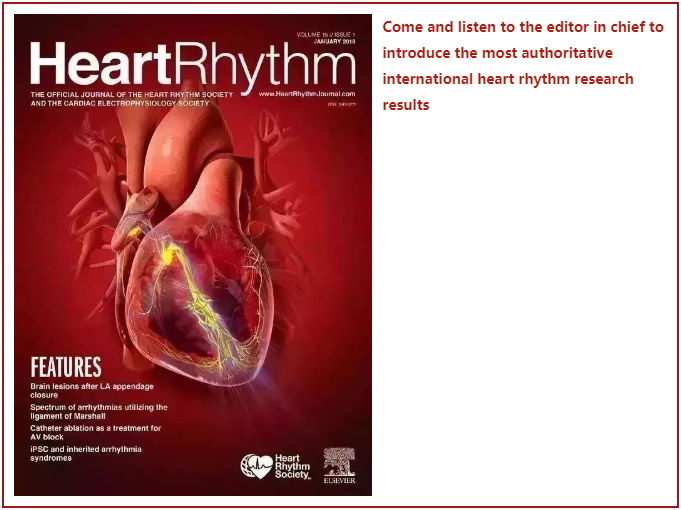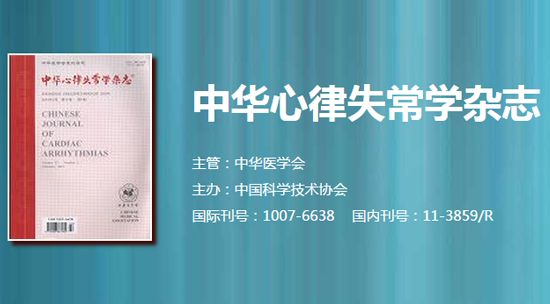HeartRhythm主编—陈鹏生教授语音速递(六月刊 英文版)


Peng-Sheng Chen
Hello, this is Dr. Peng-Sheng Chen, the Editor-in-Chief of Heart Rhythm. This is a summary of the June 2022 issue of the journal.
The first article is “Noninvasive electrocardiographic imaging-guided targeting of drivers of persistent atrial fibrillation: The TARGET-AF1 trial”. The purpose of this study was to use electrocardiographic imaging (ECGI) mapping to guide localized driver ablation in patients with persistent AF. Forty patients were enrolled. The authors found that ECGI-guided ablation plus PVI results in high freedom from AF during followup and an ablation response in a large proportion of patients. Using driver type and characteristics may facilitate a hierarchical ablation approach.
The next article is “Machine learning-derived major adverse event prediction of patients undergoing transvenous lead extraction: Using the ESC EHRA EORP European lead extraction ConTRolled ELECTRa registry”. The purpose of this study was to develop a machine learning-based risk stratification system to predict the risk of major adverse events (MAEs) after transvenous lead extraction. The authors used ELECTRa registry to train the machine learning, then applied to predict the risk of major adverse events in 3555 patients. The authors found that machine learning models incrementally improved risk prediction for identifying those at risk of major adverse events. The self-normalizing neural network has the additional advantage of providing a personalized finite risk assessment for patients. This may aid patient decision-making and allow better preoperative risk assessment and resource allocation.
Coming up is “Experience with malfunctioning leadless pacemakers: Troubleshooting and management during medium-term follow-up”. The aim of this study was to report our experience with the management of malfunctioning Nanostim leadless pacemakers, including premature battery depletion. Nanostim leadless pacemaker malfunction occurred in 20 of 49 patients (40.8%). Premature LP battery failure was observed in 18 of 20 affected patients (90%). The authors conclude that the incidence of Nanostim leadless pacemaker early-life battery failure was higher than previously reported. Nanostim leadless pacemaker extraction in an older population seems to be safe and effective. Three-monthly follow-up seems to be effective at preventing in-between Nanostim leadless pacemakers-related hospitalization.
Up next is “Microbiological diagnosis in cardiac implantable electronic device infections detected by sonication and next-generation sequencing”. Consecutive patients with clinical signs of device-related infection from 3 tertiary centers in Denmark were included in the study. In 110 patients with clinical signs of device-related infection, the authors identified the causative pathogen in 95% of cases, irrespective of device-related infection type. In pocket device-related infection, next-generation sequencing analysis of generators achieved sensitivity of 90%. For systemic DRI, blood cultures reached a sensitivity of 93%. The authors conclude that using a strategy including sonication and next-generation sequencing, they identified the causative pathogen in 95% of device-related infections.
The next one is “Current clinical practice of subcutaneous implantable cardioverterdefibrillator: Analysis using the JROAD-DPC database”. The purpose of this study was to identify the characteristics of current S-ICD therapy using a nationwide database. A total of 8690 patients implanted with ICD were analyzed. The authors found that S-ICD was more likely to be implanted in younger patients and those with a history of VF, nonsustained VT, BrS, and dialysis treatment. The proportion of S-ICD implantation increased, especially in patients with BrS. The incidence of in-hospital complications was low in S-ICD recipients.
The next paper is “The ALSTER-FLX Registry: 3-Month outcomes after left atrial appendage occlusion using a next-generation device, a matched-pair analysis to EWOLUTION”. The authors aimed to compare procedural results with WATCHMAN FLX in patients on dual antiplatelet therapy at ∼3 months with data with WATCHMAN from the EWOLUTION Registry. One hundred sixty-four consecutive patients receiving the WATCHMAN FLX device in 4 European centers were included in the retrospective ALSTER-FLX registry. As a control group for a matched-pair analysis, 1020 patients treated with the WATCHMAN device and data up to first follow-up (∼3 months) from EWOLUTION were used. The authors found that the periprocedural, early 3-month outcomes with WATCHMAN FLX demonstrate a similar safety profile and an improved sealing rate compared to the WATCHMAN device.
Next up is “Impact of baseline left ventricular volume on left ventricular reverse remodeling after cardiac resynchronization therapy”. The purpose of this study was to evaluate the impact of baseline LV volumes on LV reverse remodeling after CRT and whether this is associated with improved survival. A total of 864 patients were included, of whom 101 (12%) were in quintile 1 (<65 mL/m2), 272 (32%) in quintile 2 (65-95 mL/m2), 247 (29%) in quintile 3 (95-125 mL/m2), 151 (18%) in quintile 4 (125-155 mL/m2), and 93 (11%) in quintile 5 (>155 mL/m2). They found that many patients with larger baseline LV volumes still show significant LV reverse remodeling after CRT and had superior survival (regardless of baseline LV volumes) than did patients without LV reverse remodeling. Therefore, CRT should not be denied on the basis of severe LV dilatation.
The following article is “Predictors and outcomes of in-hospital referrals for forensic investigation after young sudden cardiac death”. A prospective 2-year analysis of in-hospital deaths following out of hospital cardiac arrest (OHCA) in Victoria, Australia, was conducted using a statewide registry combining data from ambulance, hospital, and forensic resources. They found that OHCA caused 26.3% of all deaths (n = 1301) in Victorians aged 1-50 years. Of 107 SCD patients referred to the coroner from hospitals, 25 (23.3%) had illicit substances identified on toxicologic analysis. Eighty-one patients (75.7%) underwent autopsy, with cause of death determined in 65 cases (80.2%). The authors conclude that more than one-fourth of young Victorian deaths result from OHCA. Approximately half of patients dying in-hospital following OHCA are referred to the coroner. Patients referred are younger, more likely to die in the emergency department, and reside rurally. Forensic assessment identifies high rates of illicit drug use in young SCD patients and provides a definitive cause of death for most patients.
Up next is “SCN5A mutation in Brugada syndrome is associated with substrate severity detected by electrocardiographic imaging and high-density electroanatomic mapping”.This study aimed to correlate SCN5A mutation with substrate severity in BrS assessed by ECGI and high-density electroanatomic map. Thirty-nine BrS patients with ECGI were included. Eight patients (20.5%) were SCN5A+. At the baseline ECGI map, the mean RVOT-recovery time was longer in SCN5A+ patients. After ajmaline administration, SCN5A+ patients showed longer RVOT-activation time and longer RVOT-recovery time. The authors conclude that in BrS, SCN5A+ patients compared with SCN5A- patients exhibit marked depolarization and repolarization abnormalities as assessed by ECGI and epicardial high-density electroanatomic map.
Up next is “Poor R-wave progression as a predictor of sudden cardiac death in general population and subjects with coronary artery disease”. The study population consisted of 6854 subjects. Main end points were SCD, cardiac death, and all-cause mortality. PRWP was defined as R-wave amplitude ≤ 0.3 mV in lead V3 and R-wave amplitude in lead V2 ≤ R-wave amplitude in lead V3. PRWP occurred in 213 subjects (3.1%). During the follow-up period of 24.3 ± 10.4 years, 3723 subjects (54.3%) died. PRWP was associated with adverse prognosis in the general population and with SCD in subjects with CAD.
The next one is “Statins to prevent pacing-induced cardiomyopathy: Evidence from the bench applied to clinical studies”. The purpose of this study was to explore the mechanisms and clinical outcomes of statins in AV block patients receiving pacing. Rat ventricular cardiomyocytes were treated with atorvastatin, liver X receptor (LXR) agonist, and LXR antagonist during pacing. Pigs were divided into 3 groups: right ventricular pacing, pacing with concomitant atorvastatin treatment, and sham control. The authors also enrolled 1717 AV block patients who had received a permanent pacemaker. The authors found that in the experimental models, atorvastatin ameliorated lipid accumulation in cardiomyocytes and fibrosis in left ventricular myocardium induced by pacing. Clinically, treatment with statins was associated with less HF hospitalization and cardiovascular death in AV block patients receiving pacemaker therapy. These findings support the conclusion that statins may be useful in preventing pacinginduced cardiomyopathy.
Up next is “Diagnostic accuracy of the 12-lead electrocardiogram in the first 48 hours of life for newborns of a parent with congenital long QT syndrome”. The authors conducted a retrospective review of all neonates born at Mayo Clinic to a parent with ≥1 pathogenic variant in a LQTS-causative gene who had least 1 ECG in the first 48 hours and genetic test results were available. Overall, 74 newborns were included. The mean QTc interval in the first 48 hours for neonates that ultimately were genotype-positive was greater than that for genotype-negative neonates. When using a recommended threshold QTc interval of ≥440 ms, 6 of 50 genotypepositive neonates (12%) were missed (underdiagnosed) and 17 of 24 genotype-negative neonates (71%) were overdiagnosed. The authors conclude that the newborn ECG should not be used in isolation to make the diagnosis of LQTS since it will result in many misclassifications. Genetic testing must be initiated before discharge, and proper anticipatory guidance is vital while awaiting test results.
Up next is “Structural and function organization of intrathoracic extracardiac autonomic projections to the porcine heart: Implications for targeted neuromodulation therapy”.11 Yucatan mini-pigs underwent electrical stimulation of the cervical vagi and stellate ganglia. The majority of parasympathetic and sympathetic cardiac-evoked responses were mitigated after debranching of the right vagosympathetic trunk (VST) rostral to heart, whereas the left VST demonstrated a distribution with greater dispersion and caudal intrathoracic shift compared to the right. The authors conclude that the nexus point for optimum neuromodulation engagement of parasympathetic efferent projections to the heart is the cervical vagus and the T1-T2 paravertebral chain ganglia for sympathetic control. Removal of principal sympathetic efferent projections to heart requires targeting the T1-T4 regions of the paravertebral chain.
The next article is “Stabilization of RyR2 maintains right ventricular function, reduces the development of ventricular arrhythmias, and improves prognosis in pulmonary hypertension”. The authors aimed to investigate whether direct pharmacological intervention in the RV muscle with dantrolene, a stabilizer of the cardiac ryanodine receptor (RyR2), has a protective effect against RV dysfunction and arrhythmia in a pulmonary arterial hypertension rat model. In that rat model, RV hypertrophy, dilation, and functional decline were observed, with a survival rate of 0% 2 months after induction. In contrast, chronic dantrolene treatment improved all these RV parameters and increased survival by 80%. The authors conclude that stabilization of RyR2 by dantrolene has potential as a new therapeutic agent against the development of RV dysfunction and fatal arrhythmia associated with pulmonary arterial hypertension.
Coming up next is “Genome sequencing in a genetically elusive multigenerational long QT syndrome pedigree identifies a novel LQT2-causative deeply intronic KCNH2 variant”.The purpose of this study was to identify and characterize functionally a novel LQTS genetic substrate in a multigenerational, "genotype-negative" LQTS pedigree. The patient was a 40- year-old woman with a history of syncope, seizures, ventricular fibrillation, and a family history of LQTS and sudden death. Commercial genetic testing of all LQTS-causative genes was negative. Genome sequencing was performed on 6 affected family members. The authors found a deep intronic KCNH2 variant was present in all affected individuals. They conclude that a novel deep intronic KCNH2 variant was identified in a multigenerational, genetically elusive LQTS pedigree. The iPSC-CMs establish that the variant is the monogenetic cause for this family's LQTS. Deep intronic variants within the 2 most common LQTS-susceptibility genes should be considered in patients with seemingly genetically elusive LQTS.
These original research articles are followed by 6 research letters. The titles are as follows: (1). Ultra-low energy cardioversion in a pig model of atrial fibrillation: A feasibility study, (2). Improving Adoption of Evidence-Based Implantable Cardioverter Defibrillator Programming: A single-center Experience, (3) Zero-Contrast Left Atrial Appendage Occlusion and Peridevice Leak Closure in Patients with Advanced Kidney Disease, (4) When Adenosine is not Enough, (5) Procedural and short-term follow-up outcomes of Amplatzer Amulet occluder versus Watchman FLX device: A meta-analysis and (6) Simultaneous conduction system pacing and AV node ablation via axillary vs femoral access. These letters are followed by a Creative Concept paper called “Simultaneous repair of left atrial appendage perforation and appendage closure by trans-atrial deployment of a septal occluder device: preclinical and clinical validation”.
I hope you enjoyed this podcast. For Heart Rhythm, I’m the Editor-In-Chief, Dr. Peng-Sheng Chen.











